Complimentary worldwide shipping on orders over $400 · No import tariffs for most countries
Complimentary worldwide shipping on orders over $400 · No import tariffs for most countries
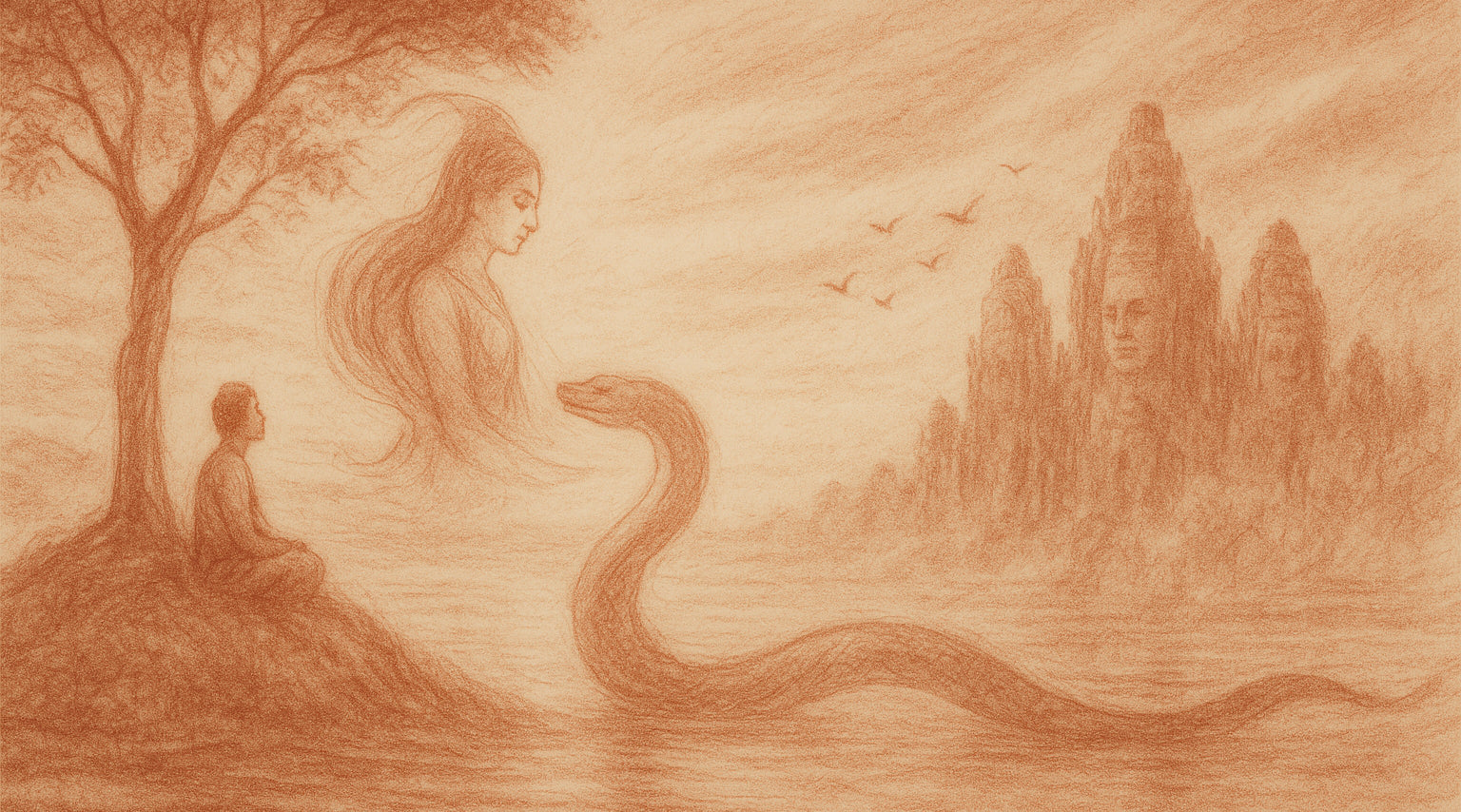
In the Beginning Was the Bayon
3 min read
“From waters deep, land arose—a whisper between naga and man.”
At Cambodia's heart, a whisper from eternity breathes softly through stone, myth, and sacred memory: Nokor Kok Thlok, Kingdom born of the Thlok Tree Knoll. Stepping gently through ruins dappled with sunlight and shadow at Angkor Thom, one senses the Bayon temple quietly breathing this ancient truth—not merely etched in carvings but held within the spirit of place itself.
Once, there was only ocean—boundless, unmarked by time. From these primordial waters rose a solitary hillock, a kok crowned with a single Thlok tree. Upon this knoll dwelled Preah Thong, alone beneath infinite skies, until the luminous naga princess Neang Neak emerged from oceanic depths. Their meeting was an alchemy of longing and destiny; mortal drawn to divine, earth intertwined with sacred waters.
Preah Thong’s love carried him beneath the waves into Badal, the naga realm. Granted Neang Neak’s hand, he returned to the kok, yearning still for earth and kingship. Compassion stirred within the naga king, who drank the encompassing seas, revealing Nokor Kok Thlok—a kingdom born of water, earth, and love. From this symbolic centre, life expanded, radiant and abundant.
Yet within the Bayon—Mount Meru made stone—resides another story, quietly profound. As myth interwove history, Preah Thong erected the temple at his kingdom’s sacred heart. But the naga king, wary of Brahma’s potent visage, cautioned against its representation. Preah Thong disregarded the divine warning, imprinting serene Brahma faces across city gates, inciting wrath and grief. In sorrowful confrontation, father battled son-in-law; the naga king fell, his blood marking Preah Thong forever with leprosy—victorious yet burdened, architect yet outcast.
Walking today through Angkor Thom, one hears ancient narratives whispered in every stone, each carving a silent invocation. Brahma’s tranquil, enigmatic faces gaze ceaselessly from Bayon’s towers, evoking timeless reflections on transgression, consequence, and divine encounter.
Deeper still, resonating subtly yet powerfully, echoes the sacred Churning of the Ocean of Milk. Angkor Thom, reborn from devastation by Jayavarman VII, crystallised anew in stone, re-enacts this cosmic drama. Bayon, symbolic Mount Mandara, rises as the sacred centre, while gates display statues eternally tugging a serpent-rope—a perpetual dance between celestial forces of light and shadow, mortality and immortality.
This profound myth endures within Khmer tradition, quietly transposed into "hauling the rope," Teanh Proat—a gentle ritual celebrated at Khmer New Year to summon rain, fertility, and renewal. Such continuity signifies not forgetfulness, but sacred transformation: myth seamlessly woven into daily existence, divinity gently shaping ordinary lives.
To truly experience Angkor is to linger at these intersections where history dissolves tenderly into myth. The Bayon’s ancient well, Andong Preng, remains revered, believed to connect directly to oceanic depths, portals through which naga kings still rise unseen. Villagers speak softly of coconuts cast into its waters, carried mysteriously to distant seas—affirmations of myth alive, quietly bridging visible and invisible realms.
Khmer cosmology teaches that Mount Meru, cosmic axis, binds heaven, earth, and oceanic depths. At Bayon, this vision finds eloquent expression: Mount Meru ascends visibly skyward, mirrored beneath by hidden, subterranean roots reaching naga depths. Bas-reliefs conceal symbolic stone fish, signifying Meru’s anchoring roots—tangible symbols grounding mythic truths.
Ancient inscriptions whisper of Jayagiri, Mountain of Victory, and Jayasindhu, Victorious Ocean—evocative names reflecting royal aspirations for eternal legacy. To traverse Angkor Thom today is to meditate upon this recreated universe, a silent reflection upon immortality, renewal, and sacred permanence. Every gateway, statue, carving offers passage into timelessness, inviting quiet communion.
Myth, like memory, gently shifts over time. Even in recent centuries, Angkor’s narratives evolve, interpretations delicately layered upon earlier meanings. In the sixteenth century, King Ang Chan continued "Maha Vishnulok’s" work, embracing Angkor Wat’s legacy, revitalising its spiritual essence. Myth thus lives, breathing gently with the present while rooted tenderly in antiquity.
Angkor Thom stands as a sanctuary of layered meaning—myth intertwined with reality, history woven into spiritual reflection. Tangible and intangible realms overlap seamlessly; daily lives softly embrace supernatural realities. Villagers quietly retell sacred tales, worshippers venerate ancient wells, pilgrims walk sacred pathways—each participating in an ongoing, gentle ritual of remembrance and renewal.
Here, stone listens patiently to centuries’ gentle passage, quietly reminding:
Beneath ancient stone,
nagas dream in ocean depths—
above, we remember.
The Bayon thus endures, softly embodying Cambodia’s eternal dance between myth and reality, reminding profoundly that all sacred beginnings reside not in distant abstraction but within the heart of the world itself—in stone’s quiet breath, and in reverent silence of those who pause, listen, and remember.
Also in Library
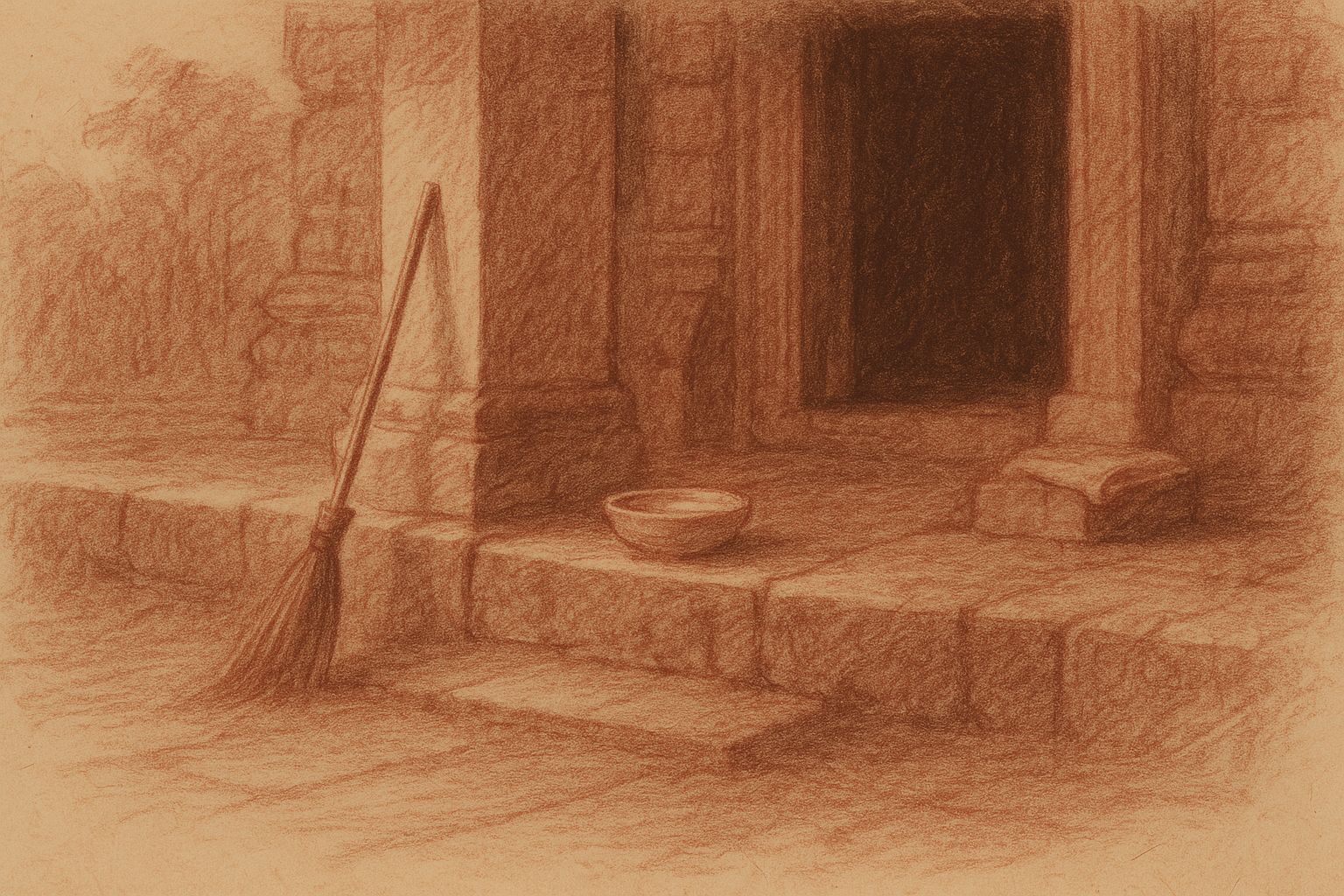
Those Who Keep the Way Open — On the Quiet Guardians of Angkor’s Thresholds
3 min read
Quiet gestures shape the way into Angkor — a swept stone, a refilled bowl, a hand steadying a guardian lion. This essay reflects on the unseen custodians whose daily care keeps the thresholds open, revealing how sacredness endures not through stone alone, but through those who tend its meaning.
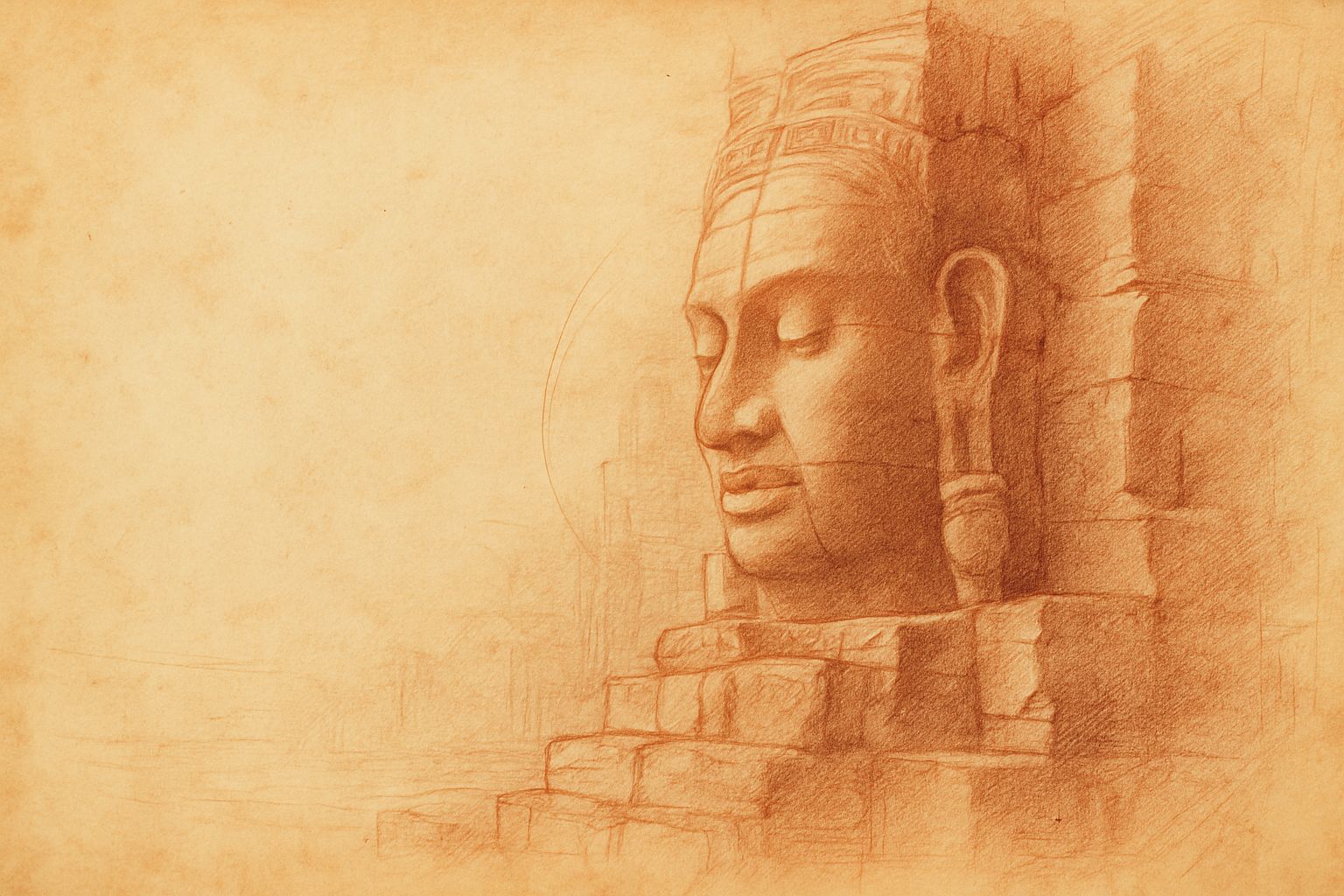
Multiplicity and Mercy — The Face Towers of Jayavarman VII
5 min read
A new vision of kingship rises at the Bayon: serene faces turned to every horizon, shaping a world where authority is expressed as care. Moving through the terraces, one enters a field of steady, compassionate presence — a landscape where stone, light, and time teach through quiet attention.
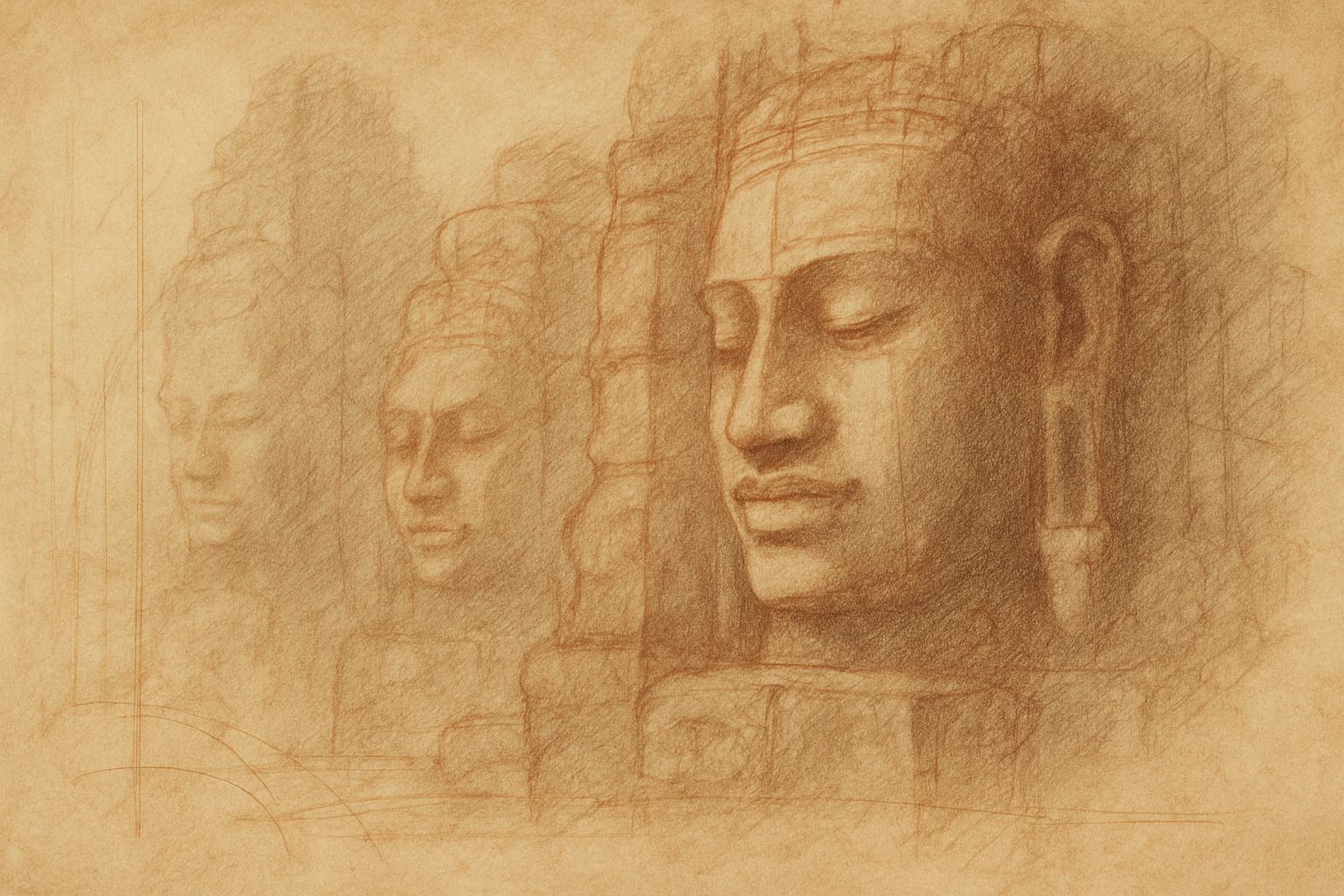
Stone That Dreams
4 min read
Bayon wakes like a mind emerging from shadow. Its many faces shift with light and breath, teaching that perception—and the self—is never singular. In walking this forest of towers, the pilgrim discovers a quiet multiplicity within, held together by a calm that feels both ancient and newly understood.
Join My Studio Journal
Receive occasional letters from my studio in Siem Reap—offering a glimpse into my creative process, early access to new fine art prints, field notes from the temples of Angkor, exhibition announcements, and reflections on beauty, impermanence, and the spirit of place.
No noise. No clutter. Just quiet inspiration, delivered gently.
Subscribe and stay connected to the unfolding story.
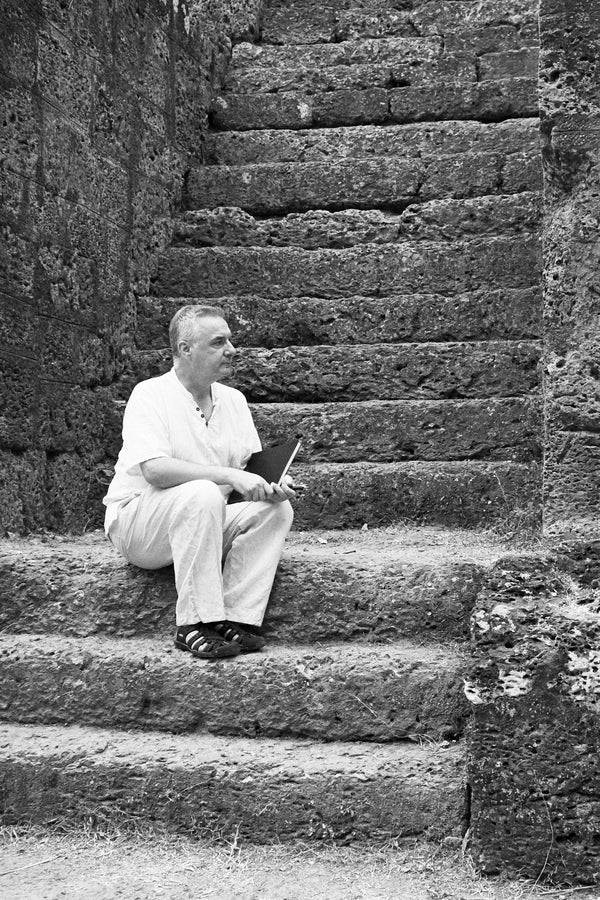
Join My Studio Journal
Receive occasional letters from my studio in Siem Reap—offering a glimpse into my creative process, early access to new fine art prints, field notes from the temples of Angkor, exhibition announcements, and reflections on beauty, impermanence, and the spirit of place.
No noise. No clutter. Just quiet inspiration, delivered gently.
Subscribe and stay connected to the unfolding story.
